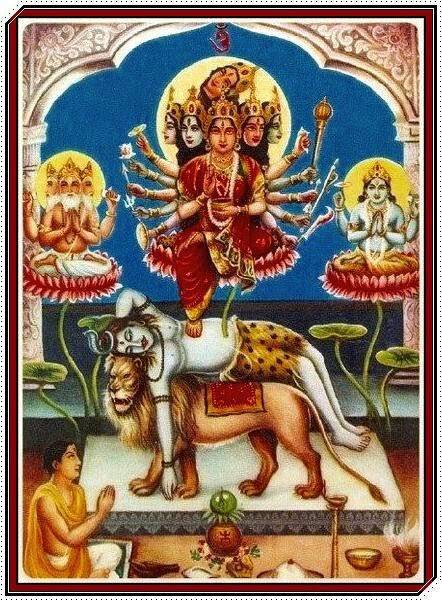No products in the cart.
Kamakhya Devi – Hindu Goddesses and Deities
 Kamakhya (Bengali: কামাখ্যা দেবী) is an important Hindu Tantric goddess that evolved in the Himalayan hills. She is closely identified with Kali and Maha Tripura Sundari. According to the Tantric texts (Kalika Purana, Yogini Tantra) that are the basis for her worship at the Kamakhya temple, a 16th-century temple in the Kamrup district of Assam. The earlier manifest of the goddess sanctified at the Garo hills is destroyed, although the Vatsayana priests are said to have carried away the manifest of the goddess to the Hindu kingdom in Kashmir and later sanctified in a remote hill forest in Himachal. Her name means “renowned goddess of desire,” and she resides at the presently rebuilt Kamakhya Temple replacing the lost manifest now in the form of a stone yoni (female generative organ) symbolic of the goddess in 1645 C.
Kamakhya (Bengali: কামাখ্যা দেবী) is an important Hindu Tantric goddess that evolved in the Himalayan hills. She is closely identified with Kali and Maha Tripura Sundari. According to the Tantric texts (Kalika Purana, Yogini Tantra) that are the basis for her worship at the Kamakhya temple, a 16th-century temple in the Kamrup district of Assam. The earlier manifest of the goddess sanctified at the Garo hills is destroyed, although the Vatsayana priests are said to have carried away the manifest of the goddess to the Hindu kingdom in Kashmir and later sanctified in a remote hill forest in Himachal. Her name means “renowned goddess of desire,” and she resides at the presently rebuilt Kamakhya Temple replacing the lost manifest now in the form of a stone yoni (female generative organ) symbolic of the goddess in 1645 C.
Kamarupa (“form of desire”) is the region in which the yoni of Sati (“vulva,” “womb,” or “source”) is said to have fallen to earth, and the Kamakhya temple was said to have been constructed on this spot.
Kamakhya as a goddess likely predates the Sanskritization of Assam. She is likely related to an important goddess of the Khasi, a tribe originally from Assam that retains matrilineal social systems (not matriarchal, however, since final authority rests with the eldest males of the maternal line).
Kamakhya is mentioned in the Kalika Purana as the most important goddess of Tantric worship, and is referred to in the text as Mahamaya, the “great goddess of illusion”, who takes on many forms depending on her mood. Devotees also call her Kameshwari (“beloved goddess of desire”), and consider her a form of Maha Tripura Sundari, also called Shodashi. She is identified with Kali in the Kalika Purana, Yoginitantra and Kamakhya Tantra, each of which echoes this verse:
“It is certainly well known that Kamakhya is truly none other than that mother goddess Kali, who is in all things the form of wisdom.”
Kamakhya is associated with the Dasa Mahavidyas, who each have temples dedicated to them at the Kamakhya temple complex in Assam. She is also closely associated with Durga.
ICONOGRAPHY:
Kamakhya is pictured as a young goddess, 16 years old, with twelve arms and six heads of varying colors, representing a powerful goddess who is omnipotent, omniscient and omnipresent. She is ornately dressed, typically wearing a red sari, opulent jewelry and red flowers such as hibiscus. She holds in each of ten hands a lotus, trident, sword, bell, discus, bow, arrows, club or scepter, goad, and shield. Her remaining two hands hold a bowl, which is made either of gold or a skull. She is seated upon a lotus, which emerges from the navel of Lord Shiva, who in turn lies atop a lion. To each side of her sit Brahma and Vishnu, who are each seated upon a lotus, as well.
FESTIVALS AND VRATS:
Festivals associated with Devi Kamakhya are: Durga Puja, Navaratri, Ambubachi Mela (an annual festival in Kamakhya Temple for Tantra worship) and Manasha Puja.
MANTRA:
According to Hindu Mythology chanting of Kamakhya Mantra regularly is the most powerful way to please Goddess Kamakhya and get her blessing.
Kamakhya Beej Mantra
क्लीं क्लीं कामाख्या क्लीं क्लीं नमः |
(Kleem Kleem Kaamaakhyaa Kleem Kleem namah |)
Kamakhya Vashikaran Mantra
Om namo kamakshi devi aamuki me vansham kuru kuru swaha |
Kamakhya Devi Mantra
Kamakhy Varade Devi Nilparvatvasini,
Twam Devi Jagatam Mataryonimudre Namostute |
Kamakhya Pranam Mantra
Kamakhye kaam sampane kamesvari hari priye,
Kaamnaam dehi me nityem kaamesvari namostute|
TEMPLE:
The Kamakhya Temple (Assamese: কামাখ্যা মন্দিৰ) is a Hindu temple dedicated to the mother goddess Kamakhya, one of the oldest of the 51 Shakti Pithas. Situated on the Nilachal Hill in western part of Guwahati city in Assam, India, it is the main temple in a complex of individual temples dedicated to the ten Mahavidyas: Kali, Tara, Sodashi, Bhuvaneshwari, Bhairavi, Chhinnamasta, Dhumavati, Bagalamukhi, Matangi and Kamala. Among these, Tripurasundari, Matangi and Kamala reside inside the main temple whereas the other seven reside in individual temples. It is an important pilgrimage destination for general Hindu and especially for Tantric worshipers.



